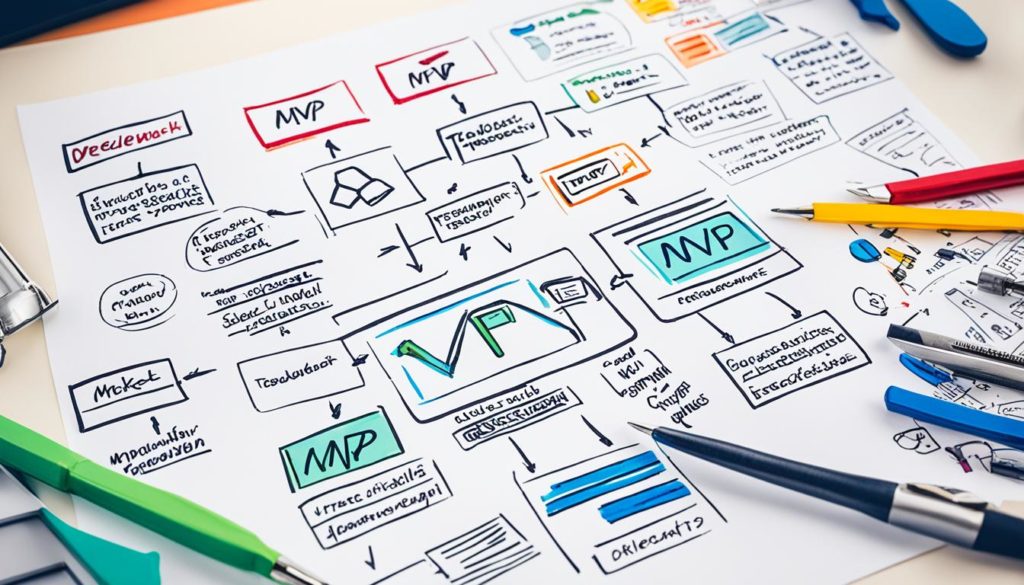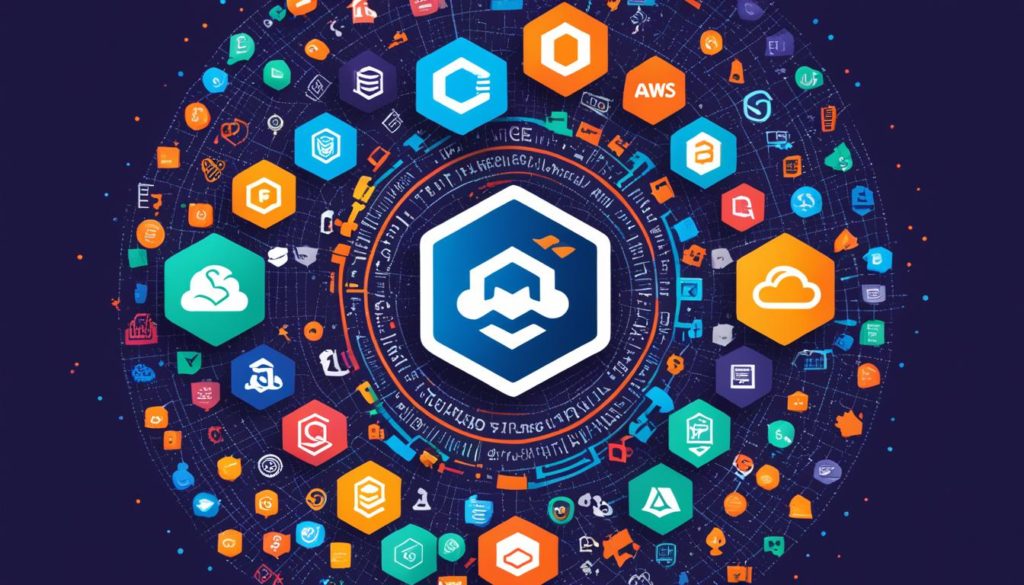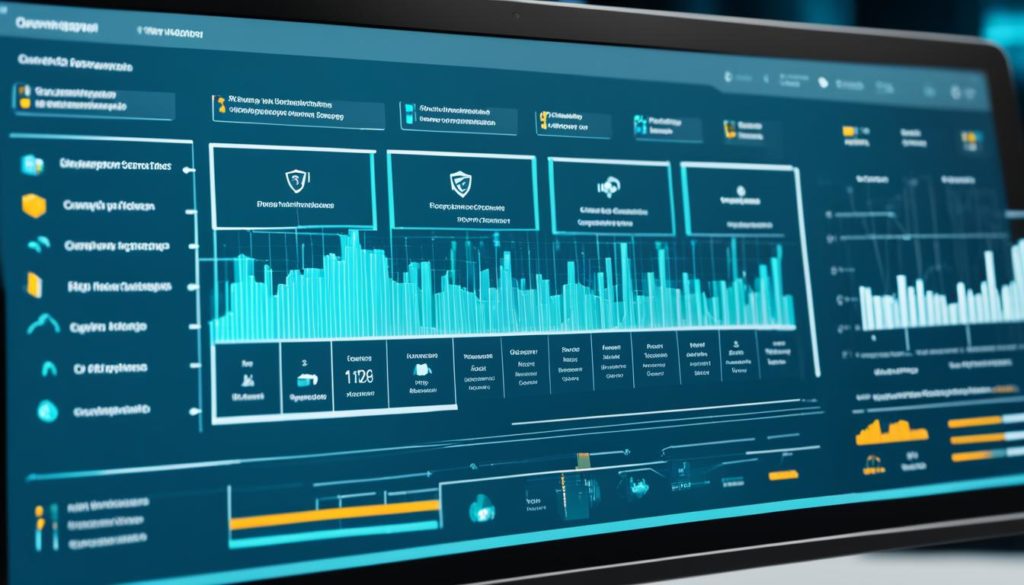
Did you know that 20% of startups fail within their first year? About 60% go bankrupt within three years. Starting a company is hard. There are many challenges like money problems and making your product right. We at Entrepreneur’s Digest know this journey very well. To help startups succeed, creating a Minimum Viable Product (MVP) is key. This minimal viable product acts as a guide for startups working to turn their ideas into real businesses.
Our journey to perfect the Product Launch Strategy has shown us that MVPs are more than a quick road. They are essential learning tools that help you stand in the market. MVPs are about getting real feedback from users without spending lots of money first. This approach is a cornerstone of the industry, following in the footsteps of successes like the iPhone and Airbnb. These big companies started with MVPs, showing that starting simple can lead to big things by focusing on what users truly need.
Let’s look closer at why a strong MVP gives any startup a competitive edge, helping them make a mark in business.
Key Takeaways
- Knowing the startup failure rate makes using an MVP crucial to reduce risk.
- MVPs save a lot of time and money, which is vital for startups with few resources.
- Having direct user feedback through an MVP is key to meeting market demands.
- A successful MVP launch can transform an early startup’s growth.
- Looking at past MVP wins can offer smart lessons for emerging startups.
Understanding the Minimum Viable Product Concept
The Minimum Viable Product (MVP) is key in the world of startups today. It stands central to lean startup practices and agile methods. Rather than just the least needed for a product, it’s about clever testing with users quickly.
Defining MVP: More Than Minimalism
The MVP is aimed at starting a learning process with real users. It’s not just the basic features but those that offer insights into user needs. This approach is vital in the product development strategy.
History and Evolution of the MVP Strategy
The MVP idea is not new, but its use has expanded greatly. Eric Ries and others have taken it from simple prototypes to complex, scaled products. For example, Zappos started with very little but grew big by earning trust gradually. The lesson here is: an MVP should fit the strategy and resources available.
The Lean Startup Methodology and MVP
In the lean startup approach, the MVP is vital. It’s matched with agile practices to refine products fast and stay close to what users want. This makes products keep up with changing market needs.
Adding MVPs to agile cycles cuts down on development time and costs. It ensures the final product is competitive. Airbnb and Foursquare are good examples. Airbnb tested its model by renting apartments. Foursquare started with just a check-in feature, growing more popular before adding other options.
Watching an MVP turn into a full product is quite a journey. It shows how lean and agile methods can help products succeed. MVPs let companies test ideas without big risks and make changes fast based on feedback. This keeps their strategy sharp and efficient.
Planning Your Minimum Viable Product
The first step in creating a Minimum Viable Product is detailed planning. It’s crucial for the product to meet market needs and offer something unique. We must talk to our intended users and do a lot of market research.
Testing the product is a key part of this process. It confirms our idea works and lets us see how users interact with it. This step includes making changes to improve the user experience and the product’s features.
The product design should focus on the user, making sure it solves their issues smoothly. We need to identify the most important features to keep the product simple yet powerful. This approach ensures our product is well-received by the first users.
- First, we check the market to understand what users want.
- We then interact with potential users to gather insights.
- Testing the product repeatedly helps refine it based on feedback.
Feedback and making constant improvements are vital during these stages. This approach allows us to quickly adjust to what users want and changes in the market. It makes the product better suited for the market and more attractive.
By sticking to these steps, we develop an MVP that exceeds expectations. It lays the groundwork for future improvements and a successful market launch.
Key Components of a Successful MVP
MVP Components are key to make a Minimum Viable Product work. They help startups make products that meet market needs. They also make sure the product grows with user feedback and business goals.
Identifying Critical Features and Value Proposition
Every MVP must have Critical Features and a Value Proposition> that early users need. It’s not about having everything, but having what matters most. Learn more on picking the right features for your MVP.
User Flow and Empathetic Design
Empathetic Design is vital for an MVP to connect with users. It makes the product natural and enjoyable to use. Creating user profiles and testing designs helps in making the experience match what users want.
Prioritization and the Product Backlog
The Product Backlog is crucial for MVP development. It sets tasks by their importance to the product’s vision. This helps focus on features essential for the MVP’s success.
Using these key elements in an MVP builds a strong start for startups. They meet market needs and can grow with user demand.
The Role of Feedback and Iterative Development
Every successful startup has a key skill – using feedback and iterative development. These are more than strategies; they’re necessary to move forward in quick markets. When starting a product, Agile development is crucial. It lets us adjust based on user feedback and market changes.
Product testing shows us how users actually use our product. We then work on it some more, using feedback for changes. This makes users happier and keeps our product ahead of the game.
- 64% of organizations are now implementing agile methodologies to better incorporate user feedback into product development.
- 48% highlight cost-efficient product testing as a major benefit of using MVP models.
We always monitor how our product is doing and tweak it. This way, every new version surprises our customers in a good way. We aim to keep up with what our customers want, making our product better each time.
| Statistic | Implication |
|---|---|
| 73% of executives believe customer feedback is growing in importance | Startups must listen to customers more than ever to succeed. |
| 82% of successful MVP startups cite quick market entry | Being fast to adapt helps new companies meet what the market needs. |
Startup founders know that checking if their product fits the market is key. They use MVPs to test and then make it better based on feedback. This way, they lower risks and increase chances of doing well.
To be successful, we need to always seek feedback and make changes. This way, our MVP becomes a product that our users really love. It creates a strong bond and keeps them interested.
Conclusion
The Minimum Viable Product isn’t just a simple first release. It’s a smart strategy for success. Look at Airbnb, Facebook, and Uber. They all started with an MVP. This move helped them grow big. It showed investors their product could connect with people.
Our wise path in making products focuses on knowing our market well. Even with lots of feedback and changes, a wrong product won’t succeed. So, the MVP is vital for making sure our idea is right before going all out. It helps us understand what customers really want. This way, we can adjust our product to be exactly what they need.
Let’s not forget how important customers are in the stories of these major companies. We can start our startup’s story the same way. By using lean methods and staying open to what the market wants, we prepare for success. This way, we’re ready to not just meet but also create new needs in our markets. This is how we invite success into our business.
FAQ
What Is a Minimum Viable Product (MVP)?
An MVP is a basic version of a new product. It lets a team learn a lot about what customers want. Without spending too much time or money, it lets the team see if their idea works. An MVP only has the main features needed to test the product.
How Does an MVP Fit Into the Lean Startup Methodology?
An MVP is key in the Lean Startup Methodology for fast learning. It tests ideas without making a whole product. This saves time and money. With an MVP, you make sure your product fits what customers really need.
Why Is Feedback Important in the MVP Process?
Feedback shows if a startup is going the right way with their product. It comes from the first people to use the product. This helps a startup improve, so their product fits the market better.
How Do You Determine the Critical Features for an MVP?
To find what features are crucial, start with the main problem your product solves. Look for the basic functions that solve this problem for your users. These core features will be the heart of your MVP.
Can You Give an Example of a Successful MVP?
Think of Airbnb’s start. It was a simple website letting people rent out their space. Just starting with air mattresses showed people wanted affordable space. Airbnb grew from this simple idea into a big success.
What Role Does Agile Development Play in Crafting an MVP?
Agile Development is vital for making an MVP quickly and with feedback. It focuses on short work periods. This means quick changes and learning from users. Agile helps startups improve their product fast.
How Long Should It Take to Develop an MVP?
Creating an MVP can be fast or slow, depending on the product and market. Some may take weeks, others several months. The important part is focusing on the essential product features to learn what customers want.
Is Prototyping the Same as Developing an MVP?
Not quite. Prototyping is about showing if an idea works. It’s for testing basic functions. An MVP is further along, ready for customers to try. It focuses on learning from those real experiences.
What’s the Next Step After Launching an MVP?
After an MVP launch, the next step is to collect user feedback. Watch how your product is used and compare it to your goals. Use this feedback to make your product better. This process of feedback and change should continue until your product fits the market well.
How Do You Balance Speed and Quality When Developing an MVP?
To balance speed and quality in MVP development, make it good enough to test ideas but not perfect. You should focus on what your users really need. Avoid spending time on extra features that don’t add to your MVP’s core goals.
Future App Studios is an award-winning software development & outsourcing company. Our team of experts is ready to craft the solution your company needs.









